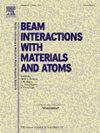Fabrication and validation of new tissue equivalent heterogeneous composite materials as neonatal and pediatric cranial bone substitutes in diagnostic radiology
IF 1.4
3区 物理与天体物理
Q3 INSTRUMENTS & INSTRUMENTATION
Nuclear Instruments & Methods in Physics Research Section B-beam Interactions With Materials and Atoms
Pub Date : 2025-03-04
DOI:10.1016/j.nimb.2025.165671
引用次数: 0
Abstract
This study explores the development of heterogeneous composite materials as pediatric cranial bone substitutes by incorporating sodium bicarbonate and calcium carbonate within an epoxy resin matrix. The aim was to tailor the material’s radiation interaction properties for various pediatric age groups. The fabrication involved mixing specific percentages of fillers for uniform dispersion in epoxy resin, followed by curing. Monte Carlo simulations evaluated the materials’ attenuation properties, revealing varying percent differences in mass attenuation compared to ICRU-reported values of compact and cortical bones. For infant bone material, the differences averaged 34.3 % and 37.5 %, while those for children aged 1–5 years were 13.4 % and 19.3 %, and for children over 5 years, 5.96 % and 12.8 %. Hounsfield Unit values ranged from 576 ± 30 for infants to 952 ± 18 for children aged 10–15 years. Good agreement was demonstrated with pediatric bone tissues, showing the composite’s potential for mimicking pediatric cranial bone.
新型组织等效异质复合材料在诊断放射学中作为新生儿和儿童颅骨替代品的制备和验证
本研究通过在环氧树脂基质中加入碳酸氢钠和碳酸钙,探索了异质复合材料作为儿童颅骨替代品的发展。目的是为不同的儿童年龄组量身定制材料的辐射相互作用特性。制造过程包括混合特定百分比的填料,使其均匀分散在环氧树脂中,然后进行固化。蒙特卡罗模拟评估了材料的衰减特性,揭示了与icru报道的致密骨和皮质骨的质量衰减值相比,质量衰减的百分比差异。婴儿骨材料差异平均为34.3%和37.5%,1-5岁儿童差异平均为13.4%和19.3%,5岁以上儿童差异平均为5.96%和12.8%。Hounsfield单位值范围为婴儿576±30至10-15岁儿童952±18。良好的协议被证明与儿童骨组织,显示复合材料的潜力,模仿儿童颅骨。
本文章由计算机程序翻译,如有差异,请以英文原文为准。
求助全文
约1分钟内获得全文
求助全文
来源期刊
CiteScore
2.80
自引率
7.70%
发文量
231
审稿时长
1.9 months
期刊介绍:
Section B of Nuclear Instruments and Methods in Physics Research covers all aspects of the interaction of energetic beams with atoms, molecules and aggregate forms of matter. This includes ion beam analysis and ion beam modification of materials as well as basic data of importance for these studies. Topics of general interest include: atomic collisions in solids, particle channelling, all aspects of collision cascades, the modification of materials by energetic beams, ion implantation, irradiation - induced changes in materials, the physics and chemistry of beam interactions and the analysis of materials by all forms of energetic radiation. Modification by ion, laser and electron beams for the study of electronic materials, metals, ceramics, insulators, polymers and other important and new materials systems are included. Related studies, such as the application of ion beam analysis to biological, archaeological and geological samples as well as applications to solve problems in planetary science are also welcome. Energetic beams of interest include atomic and molecular ions, neutrons, positrons and muons, plasmas directed at surfaces, electron and photon beams, including laser treated surfaces and studies of solids by photon radiation from rotating anodes, synchrotrons, etc. In addition, the interaction between various forms of radiation and radiation-induced deposition processes are relevant.

 求助内容:
求助内容: 应助结果提醒方式:
应助结果提醒方式:


